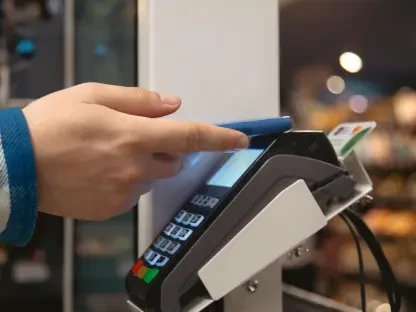Setting the Stage for Digital Dominance
In the fast-paced realm of fast-moving consumer goods (FMCG) e-commerce, a striking statistic captures the current landscape: the top 100 brands command an impressive 21% of global market value, highlighting a transformative shift where digital platforms have become the battleground for consumer loyalty and sales growth. As online shopping continues to redefine purchasing habits, the industry faces unprecedented opportunities and challenges, with major players leveraging cutting-edge technology to stay ahead.
This report delves into the dynamics propelling FMCG e-commerce, exploring how dominant brands, emerging private labels, and innovative digital strategies shape market evolution. The focus spans critical trends, consumer behaviors, and competitive pressures that define success in this space. By examining key data and insights, a comprehensive picture emerges of an industry at a pivotal moment of growth and transformation.
The significance of this digital shift cannot be overstated, as nearly one-third of the top 100 brands generate over $1 billion in annual online sales. With 12 product categories and 15 key markets driving this expansion, understanding the forces at play offers valuable lessons for stakeholders aiming to navigate this competitive arena.
Overview of the FMCG E-Commerce Landscape
Current Market Dynamics and Significance
The FMCG e-commerce market stands as a cornerstone of the global economy, experiencing rapid expansion fueled by changing consumer preferences and technological advancements. Online sales channels have become integral to the industry, with digital platforms facilitating seamless access to a vast array of products. This growth reflects a broader trend of convenience-driven shopping, positioning e-commerce as a vital component of economic activity worldwide.
Key market segments such as packaged goods, personal care, and household products dominate the online space, each contributing significantly to overall sales. Packaged goods, in particular, benefit from high repeat purchase rates, while personal care items see increased demand through targeted digital marketing. Household products, often tied to subscription models, further illustrate the diversity and resilience of FMCG categories in meeting everyday consumer needs.
The economic impact of this sector extends beyond sales figures, influencing supply chains, employment, and innovation. As digital adoption accelerates, the importance of e-commerce in sustaining market relevance for FMCG brands becomes increasingly clear, setting the stage for intense competition and strategic maneuvering among industry leaders.
Role of Major Players and Digital Influence
Dominance in the FMCG e-commerce market is heavily concentrated among top brands, with the leading 100 players accounting for a substantial 21% of global value. These industry giants leverage their established reputations and vast resources to maintain a competitive edge, often outpacing smaller contenders through economies of scale and brand recognition. Their ability to adapt to digital trends has cemented their position at the forefront of market evolution.
Digital tools play a pivotal role in this success, with predictive customer journey mapping enabling brands to anticipate consumer needs and tailor experiences accordingly. Diversified online touchpoints, from social media to dedicated apps, further enhance engagement, ensuring that these major players remain visible and relevant across multiple platforms. Such strategies transform raw data into actionable insights, driving sales and loyalty.
The influence of digital innovation extends to brand equity, as consistent online interactions build trust and preference among consumers. By prioritizing a seamless digital presence, top brands not only capture market share but also set benchmarks for others, highlighting the critical intersection of technology and market leadership in today’s FMCG landscape.
Key Trends Shaping FMCG E-commerce Growth
Rise of Private Labels and Premiumization
A notable trend in FMCG e-commerce is the growing prominence of retailer-led private label brands, with 19 securing spots among the top 100 and contributing 25% of ranked brands’ online sales. These labels, often backed by major retailers, have gained traction by offering competitive pricing without sacrificing quality. Their rise signals a shift in consumer trust toward store-owned brands as viable alternatives to traditional names.
Brands such as Great Value, Tesco, and Kirkland Signature exemplify this balance, catering to cost-conscious shoppers while also venturing into premium segments. This dual focus on affordability and quality allows private labels to appeal to a broad spectrum of consumers, enhancing their market penetration. Their success is further amplified by integration within parent companies’ retail ecosystems, providing a seamless shopping experience.
Premiumization within private labels also reflects a broader industry trend, as brands like M&S and Member’s Mark target discerning buyers seeking value-added products. By closing the quality gap with established competitors, these labels redefine market expectations, pushing traditional brands to innovate and adapt to maintain their foothold in an increasingly competitive space.
Emergence of Chinese Brands and Global Expansion
The ascent of Chinese brands in the global FMCG e-commerce arena marks another significant development, with six entries among the top 100 driven by robust domestic performance and cross-border strategies. These brands capitalize on a massive home market while expanding their reach through international platforms, showcasing the potential for regional players to achieve global impact. Their growth underscores shifting dynamics in market influence.
Premium baijiu brands like Wu Liang Ye and Moutai, ranking tenth and eleventh respectively, demonstrate success through controlled distribution and strategic pricing on leading online marketplaces. Their focus on domestic consumers, paired with cultural resonance, has fueled strong sales figures. This approach highlights how localized strategies can translate into broader e-commerce achievements.
Other Chinese brands, such as Proya and Yili, are carving out an international presence by leveraging social media visibility and partnerships with global marketplaces. Their ability to connect with diverse audiences through digital channels illustrates a blueprint for expansion, positioning Chinese FMCG players as formidable competitors on the world stage and reshaping traditional market hierarchies.
Consumer Demand Dynamics in FMCG E-commerce
Balancing Affordability and Premium Appeal
Consumer behavior in FMCG e-commerce reveals a complex interplay between affordability and a growing desire for premium or specialized products. While price remains a primary consideration for many online shoppers, there is a clear demand for items that offer superior quality or unique experiences. This duality challenges brands to cater to varied preferences without alienating key customer segments.
Brands addressing this balance often succeed by emphasizing exclusivity or craftsmanship in their premium offerings, even amid economic pressures. For instance, limited-edition products or personalized options resonate with consumers seeking something beyond the ordinary. This strategy not only drives sales but also fosters brand loyalty among those willing to invest in distinctive items.
At the same time, maintaining accessible pricing for core products ensures broad market reach, allowing brands to appeal to budget-conscious buyers. This dual approach reflects an adaptive mindset, where understanding and responding to diverse consumer needs becomes a cornerstone of sustained growth in a fluctuating digital marketplace.
Market Data and Growth Insights
Data underscores the scale of FMCG e-commerce, with nearly one-third of the top 100 brands surpassing $1 billion in annual online sales. Spanning 12 categories and 15 key markets, these figures highlight the sector’s vast potential and the concentrated success of leading players. Such statistics provide a clear benchmark for assessing market performance and competitive positioning.
Looking ahead, growth projections remain optimistic, with trends indicating continued expansion across various product segments and geographic regions from 2025 onward. Emerging markets, in particular, offer untapped opportunities as digital infrastructure improves and consumer adoption rises. This forward-looking perspective suggests a robust trajectory for online FMCG sales.
The diversity of categories, from food and beverages to personal care, further fuels this growth, as brands tailor strategies to specific consumer demands within each segment. By aligning with these insights, industry players can better anticipate shifts and allocate resources to capitalize on evolving market dynamics over the coming years.
Challenges Facing FMCG E-commerce Players
Competitive Pressures and Market Consolidation
A significant challenge in FMCG e-commerce lies in the market’s consolidation, where a smaller group of dominant brands creates high barriers for emerging or smaller players. This concentration of power limits opportunities for new entrants, as established names leverage brand recognition and resources to maintain their grip. The result is a highly competitive environment with restricted room for growth.
Innovation becomes a critical differentiator under these conditions, as brands must continually evolve their digital strategies to capture consumer attention. Staying ahead requires investment in technology and creative marketing to sustain engagement, often at significant cost. Smaller players, lacking similar budgets, face an uphill battle to carve out meaningful market share.
Additionally, the pressure to maintain relevance amid consolidation drives mergers and acquisitions, further reshaping the competitive landscape. For many, survival hinges on finding niche opportunities or partnering with larger entities, highlighting the stark realities of operating in a market skewed toward a select few.
Navigating Pricing and Consumer Expectations
Balancing value perception with profitability poses another hurdle for FMCG e-commerce players, especially in a price-sensitive market. Consumers expect competitive pricing, yet brands must ensure margins remain viable to support operations and innovation. Striking this equilibrium demands careful strategizing to avoid eroding trust or financial stability.
Meeting evolving consumer expectations adds complexity, as demands for quality, convenience, and affordability intensify. Brands face scrutiny over delivery speed, product consistency, and overall experience, requiring robust logistics and customer service frameworks. Failure to align with these priorities risks losing market relevance in a crowded digital space.
Strategies to address these challenges often involve dynamic pricing models and enhanced value propositions, such as bundled offers or loyalty programs. By focusing on transparency and responsiveness, brands can better navigate the delicate balance of meeting expectations while safeguarding their bottom line in an unforgiving market.
Strategic Importance of Digital Presence and Brand Equity
Building Distinctive Online Identities
A strong digital presence stands as a linchpin for transforming brand equity in FMCG e-commerce, enabling companies to differentiate themselves in a saturated market. Crafting a distinctive online identity through consistent messaging and visual storytelling fosters deeper connections with consumers. This approach turns casual browsers into loyal advocates over time.
Online ecosystems play a crucial role, as brands utilize websites, apps, and social platforms to build lasting relationships. Personalized interactions, driven by data analytics, enhance user experiences, ensuring that digital touchpoints resonate with individual preferences. Such efforts elevate a brand’s standing beyond mere transactions to meaningful engagement.
The emphasis on digital identity also aligns with broader consumer trends favoring authenticity and accessibility. By prioritizing these elements, brands not only stand out but also cultivate trust, a vital asset in sustaining long-term success within the competitive e-commerce environment.
Impact of Omnichannel Strategies and Innovation
Omnichannel strategies have emerged as a powerful driver of sales for both traditional and private label brands in FMCG e-commerce. By integrating online and offline channels, companies create a cohesive shopping journey that maximizes convenience and reach. This seamless approach ensures consumers encounter consistent branding, whether browsing digitally or in-store.
Innovation in digital tools further amplifies this impact, with advancements like AI-driven recommendations and mobile-first interfaces enhancing user engagement. Strategic pricing, tailored to different platforms, also plays a role in capturing diverse customer segments. These innovations reflect a proactive stance in meeting modern shopping expectations.
The combined effect of omnichannel presence and technological progress enables brands to adapt swiftly to consumer needs, reinforcing market positions. As competition intensifies, those investing in such strategies are better equipped to navigate disruptions and maintain relevance across varied purchasing contexts.
Future Outlook for FMCG E-commerce Evolution
Emerging Opportunities and Market Disruptors
The horizon for FMCG e-commerce brims with potential, particularly through the continued expansion of Chinese brands and premium product segments. As these players strengthen their global footprint, they introduce fresh competition and innovation, reshaping market norms. Their influence signals a diversification of dominant forces within the industry.
Social media and international marketplaces stand out as key disruptors, offering platforms for visibility and sales that bypass traditional barriers. These channels enable brands to reach untapped audiences with agility, often at lower costs than conventional marketing. Their role in driving future dynamics cannot be underestimated as digital adoption deepens.
Additionally, niche opportunities in emerging markets and specialized categories present avenues for growth, encouraging brands to explore beyond saturated spaces. By aligning with these trends, industry players can position themselves to capitalize on shifts that promise to redefine competitive landscapes in the near term.
Innovation and Consumer Trends
Digital innovation remains a cornerstone of future FMCG e-commerce evolution, with advancements in AI, augmented reality, and data analytics poised to transform how brands interact with consumers. These tools enable hyper-personalized experiences, streamlining purchasing decisions while enhancing satisfaction. Staying at the forefront of such progress is essential for market relevance.
Shifting consumer preferences also shape this trajectory, as demands for sustainability, transparency, and convenience gain prominence. Brands responding to these priorities through eco-friendly practices or streamlined services stand to build stronger connections. This alignment with values reflects a deeper understanding of modern buyer motivations.
Global economic conditions and technological breakthroughs will further influence growth, introducing both opportunities and uncertainties. Navigating this landscape requires agility and foresight, as brands must anticipate changes while investing in solutions that resonate with an ever-evolving consumer base over the coming years.
Reflecting on Insights and Charting the Next Steps
Looking back, the exploration of FMCG e-commerce revealed a landscape dominated by top brands that hold significant market share, while private labels carve out substantial influence through value and quality. The rise of Chinese brands as global contenders and the sustained demand for premium offerings amid affordability concerns paint a picture of a multifaceted industry. Digital strategies and consumer-centric approaches proved central to navigating this complex terrain.
Moving forward, actionable steps emerge as critical for sustained success. Brands are encouraged to bolster their online presence through innovative digital tools and distinctive identities, ensuring they stand out in a crowded market. Investment in cross-border e-commerce and social media-driven visibility offers promising avenues to expand reach and engagement with diverse audiences.
Further consideration is given to premium offerings as a growth frontier, where balancing exclusivity with accessibility could unlock new consumer segments. Adapting to diverse needs through tailored strategies and robust omnichannel frameworks also surfaces as a priority. These insights provide a roadmap for stakeholders to thrive amid evolving challenges and opportunities in the digital marketplace.









